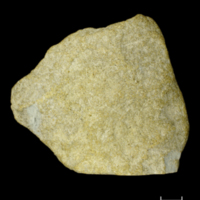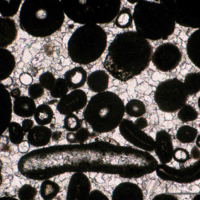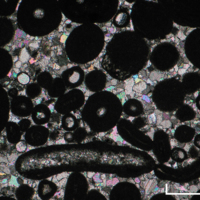- Home
- Rocks
- Type fossils
- Fossil Specimens
- Minerals
- Glossary
- Stratigraphic Chart
- Michel-Levy Chart
- Classification of igneous rocks
- University of Cambridge
- Department of Earth Sciences
- ESC Library
- Moodle
- Sedgwick Museum
- DoITPoMS
- Mindat.org
- Microfossils
- Bryozoans
- Webmineral
- Tree of Life
- CrystalMaker
- Virtual Microscope
L353 - Limestone, oolitic packstone
Age
Upper Jurasssic
Location
Corallian, Weymouth
Hand Specimen
Grey-buff colour rock made up of ooids, mainly medium grained and spherical.
Some shell and lithic fragments.
Well compacted and cemented by calcite, which fizzes with acid.
Thin-section
The ooids look brown. They are made up of calcite grains much smaller than the thickness of the slide (which is 30μm). These small grains refract, diffract and reflect light travelling through the slide producing the brown appearance of the ooids. Most of the ooids were formed around a central nucleus (usually an angular quartz grain, sometimes a shell fragment).The calcite forming the ooids is mostly too fine-grained to distinguish individual crystals.
Only some of the ooids appear to be touching in thin-section, but taking account of their 3D relationships, the rock is probably clast supported.
Rounded shell fragments including aragonite bivalve moulds and silicified brachiopods.
Occasional quartz grains.
Clean, colourless calcite cement.
This is a packstone (Dunham naming system) or oo-biosparite (Folk naming system).
Only some of the ooids appear to be touching in thin-section, but taking account of their 3D relationships, the rock is probably clast supported.
Rounded shell fragments including aragonite bivalve moulds and silicified brachiopods.
Occasional quartz grains.
Clean, colourless calcite cement.
This is a packstone (Dunham naming system) or oo-biosparite (Folk naming system).
Rock History
Deposited in a moderate energy, marine environment.
Rock Name
oolitic limestone
packstone
oo-biosparite
oolite
packstone
oo-biosparite
oolite



